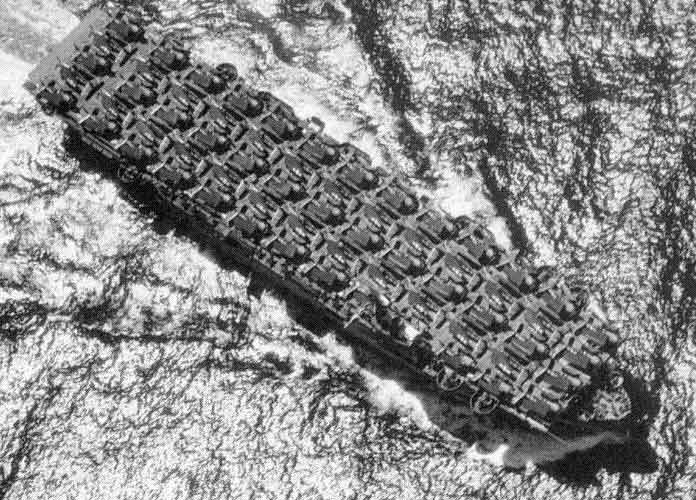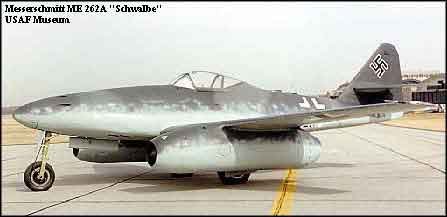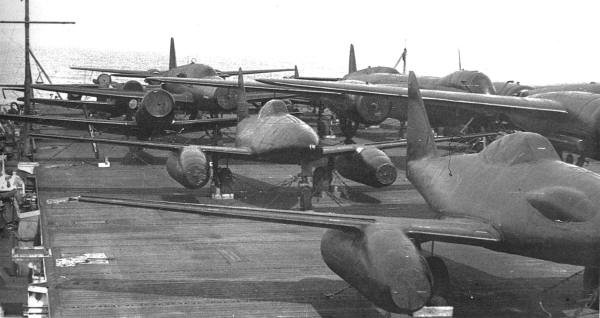|
From the
"Dictionary of American Naval Fighting Ships," (1981) Vol. 8,
pp.415-416. WINJAH WINJAH (ACV-54)--a PRINCE WILLIAM-class escort
carrier--was laid down on 5 June 1943 at Tacoma, Wash., by the
Seattle-Tacoma Shipbuilding Co.; assigned to the United Kingdom
under lend-lease on 23 June; redesignated CVE-54 on 15 July;
launched on 22 November; and delivered to the British on 18 February
1944. Renamed REAPER (D.82), the carrier operated in the Royal Navy
for the duration of World War II. After arriving at Norfolk, Va., on
13 May 1946, REAPER was decommissioned on 20 May and returned to the
United States Government. Authorized for disposal on 14 June, WINJAH
was struck from the Navy list on 8 July and sold to the Waterman
Steamship Co., of Mobile, Ala. on 12 February 1947.
H.M.S. Reaper ( D82 )
Ruler Class Ferry Carrier
Laid down: 5 June 1943.
Launched: 22 November 1943.
Completed: 21 February
1944.
Builder: Seattle Tacoma
Shipbuilding Corp., Seattle.
Machinery: 1-Shaft Allis
Chalmers geared turbine; 2 Foster Wheeler boilers; 8,500 shp=18
knots.
Displacement: 11,400 tons
standard 15,390 tons deep load.
Dimensions: 492ft overall x
108ft 6in max. beam x 25ft 5in max. draught.
Gun armament: 2 single 5in
US Mk 12 (2); 8 twin 40mm Bofors (16); 14 twin 20mm Oerlikon (28); 7
single 20mm Oerlikon.
Fuel: 3,160 tons FFO.
Endurance: 27,500 miles @
11 knots.
Complement: 646.
Protection: Splinter
protection for bomb room.
Flight Deck: 450ft x 80ft
wood covered steel.
Arrester wires: 9 x 19,800
lb @ 55 knots; 3 Barriers.
Hangar: 260ft x 62ft x
18ft.
Catapults: 1 x H4C;
16,000lb @74 knots(tail down method only).
Lifts: fwd 42ft long
x 34ft wide; aft 34ft long x 42ft wide; both 14,000lb.
Aircraft: Up to 90 could be
ferried; up to 30 could be operated.
Aircraft fuel: 36,000
gallons Avgas.
Air weapons: None carried.
Notes: One of 23 ships of
the USN. Prince William Class transferred to the R.N. under
lend/lease arrangements and named, in the main after types of
'Ruler'. This ship was built from the outset as a carrier but based
on the US C3.
H.M.S. Reaper
ferried No.1850 Squadron from New York, USA to Belfast, Northern
Ireland from the 23rd November 1944 to 6th December 1944.
H.M.S. Reaper,
ferrying a full deck load of Aircraft in April 1945.

|
|
HMS
REAPER
Training and Escort Carrier
Ex USS Winjah ACV/AVG-54/CVE-54
Became South Africa Star 1948
History
HMS Reaper (D-62) was built as a Ruler Class escort carrier in the
USA at Seattle-Tacoma and laid down 5 June 1943 as USS Winjah
ACV/AVG-54. Launched 22 November 1943, she was transferred to the
Royal Navy on 18 February 1944, and commissioned 21 February 1944
The ruler Class was the
third group of escort carriers built in the USA for the Royal Navy,
and were generally similar to the preceding "Attacker" Class. The
modifications carried out to the earlier class after their arrival
in the UK were incorporated in the "Ruler" Class during
construction. Many of the class were used as amphibious support
carriers, taking part in the invasion of Southern France. Others
supported Eastern Fleet operations against Burma and Malaya, and
some served with the British Pacific Fleet as escorts for the Fleet
Train.
HMS Reaper was built as an
Assault Carrier for duties in 1944 - 5. She was mainly employed on
ferry and transport duties, including convoy escort and training in
the Atlantic.
With the collapse of the
German forces in 1945, HMS Reaper was called upon to take part in a
top secret mission, code named Operation Lusty which started
on 22 April 1945. The USAAF Intelligence Service had sent teams to
Europe to gain access to enemy aircraft, technical and scientific
reports, research facilities, and weapons for study in the US.
Operation LUSTY began with the aim of exploiting captured German
scientific documents, research facilities, and aircraft, the
searchers nicknamed "Whizzers" located nine Me 262 jet aircraft at
Lechfeld airfield, and travelled far and wide over Europe by jeep
and occasionally by air to find the aircraft on the "Black Lists."
Once found, the Royal Navy were willing to loan the aircraft carrier
HMS Reaper. The most viable harbour for docking the carrier and
loading the various aircraft was at Cherbourg, France. The "Whizzers"
flew the Me 262s and other aircraft from Lechfeld to St. Dizier, to
Melun, and then to Cherbourg. All the aircraft were cocooned against
the salt air and weather, loaded onto the carrier which sailed in
July 1945 for the USA, where they were studied by the Air
Intelligence groups of both the USAAF and Navy.

The Me
262A, the world's first operational turbojet aircraft, on display at
the USAF Museum (USA)
was taken
to the US from Germany onboard HMS Reaper in July 1945 for flight
evaluation.
Reaper was finally returned
to the USN by the Royal Navy on 20 May 1946, and became mercantile
South Africa Star 1948, scrapped Milhara 1967.
Battle Honours
Atlantic 1944
Captains
No information on Captains.
Squadrons and
Aircraft
No information
Associations and
Reunions
No information
Carrier name
HMS Reaper
Built as USS Winjah ACV/AVG-54.
became mercantile South Africa Star 1948 Class Ruler Type Training and Escort Carrier (US built) Ships in Class
Ameer, Arbiter, Atheling, Begum, Emperor, Empress, Khedive, Nabob,
Patroller, Premier, Puncher, Queen, Rajah, Ranee, Reaper, Ruler,
Shah, Slinger, Smiter, Speaker, Thane, Trouncer, Trumpeter
Launched Laid down 5 June 1943. Launched 22 November 1943,
Transferred 18 February 1944, Commissioned 21 February 1944
Tonnage 8,333 tons, Gross displacement 14,000 tons, Load 5667
tons
Engines
2 x Foster-Wheeler boilers; 2 x Westinghouse geared turbines at 8500
shp, 1 shaft Speed in Knots 18 knots Armament Gun 2 x
1 x 5"/38-cal DP 8 x 2 x 40mm AA 27-35 x 1 x 20mm AA Crew
Complement 646 Officers & Ratings including Air Group Range
Length (ft/inches) 496 Beam (ft/inches) 69' 6" Draught
(ft/inches) 23'3" Flight Deck length (ft/inches) 470'
Flight Deck width (ft/inches) 70' Armour Number of
aircraft carried 18-24 Fate of carrier scrapped Milhara
1967.
O P E R A T I O N S E A
H O R S E
Final Preparations and the Voyage Home
As luck would have it, Anspach was in for another
wild ride a week later. This time, he was ferrying one of the
two-seaters (# 555
<../planes/555.htm>)
to Cherbourg:
On 6 July 1945, I departed Melun at 1000 hours
... the trip was uneventful until the landing approach was
initiated. Upon lowering the landing gear, I received indication
of the main- gear extending but no panel light that the nose gear
was down. I activated the emergency gear-down switch, which was a
compressed air cylinder, but still did not receive a gear-down
indication.
I had earlier received a green light from the
tower to land so I continued on the approach expecting a red light
if the nose gear was not fully extended. I thought the gear was
extended and that the down-indicator was unreliable. Inasmuch as I
received no red light from the tower I continued my approach, and
touched down normally on the main gear, holding the nose off the
ground as long as possible. After rolling approximately 1/3 the
length of the runway, I slowly lowered the nose and found I did
not have gear extension.
The aircraft slid for 800 to 1000 feet straight
ahead on the nose section, engine nacelles and main gear before
stopping. I was surprised to find very little damage had been
inflicted to the aircraft.
All that was required to make it flyable was to
replace the nose section and the front portion of each engine
nacelle. I took several mechanics and flew to Lechfeld in a C-47.
We removed the needed components from another Me
262 . The damaged sections of the the trainer were replaced and
the aircraft loaded on board the aircraft carrier.
Once all of the aircraft had arrived at the port, Army Lieutenant
Colonel "Bud" Seashore supervised the load out sequence. He happened
to be an old friend of Bob Strobell's from his days at the 1st
Tactical Air Force headquarters.
The latter had once been assigned to fly Seashore all over the
continent in a search for suitable chateaux, resorts and other
"relaxation centers" which could be contracted to serve war weary
troops. It had been an especially memorable mission for Strobell,
and he was greatly amused to learn that his old friend was now
living aboard a well-appointed crane barge in the harbor.
Strobell made arrangements to retrieve his personal gear prior to
the trip, and was in Mannheim on the 4th of July. It was to prove a
fateful day for him: he was assigned a war-weary P-47 for his trip,
and on takeoff the manifold blew, spraying atomized fuel into the
cockpit. It quickly ignited, engulfing Strobell in flames.
Though he successfully bailed out of the plane, third degree
burns landed him in the hospital for several weeks. As a result of
this incident, he missed the Reaper's departure date, and was
not able to remain with the program. (He also lost hundreds of
project documents and some 25 rolls of undeveloped film in the
fire.)


The H.M.S Reaper loading at Cherbourg. Credit-Brown

During the Reaper's load out, each of the aircraft was
given a protective "shrink wrap" to protect it from the sea spray. A
shipping control number was assigned, and the planes were then
placed on powered barges known as "Rhinos." Once the Rhinos were in
position, the aircraft were hoisted onto the deck of the carrier.
This was repeated for nearly 40 aircraft of various types.

All of the planes were finally inventoried, loaded and lashed to
the deck of the H.M.S. Reaper, and the officers and men
settled in for the long trip home. The carrier departed Cherbourg on the 19th of July
1945, bound for Newark.

Once at sea, there was little to do but relax and
enjoy the voyage. The men of the Royal Navy proved to be gracious
hosts, and between the ship's stores and a few cases of Cognac the
American officers had intended to bring home with them, there were
frequent causes for celebration. Ken Holt observed later that it was
a wonder that the Reaper reached the States at all, as the
ship's navigator was rarely ever sober enough to carry out his
duties.
While the officers relaxed by throwing empty
bottles overboard, the crew chiefs played cards with the British
sailors. Two of the American sergeants won several thousand dollars
in the process, and later had to devise creative ways of clearing
customs. There was little news from home except for word that a B-25
bomber had crashed into the Empire State building. For the first
time since the war's end, the men were headed home. |